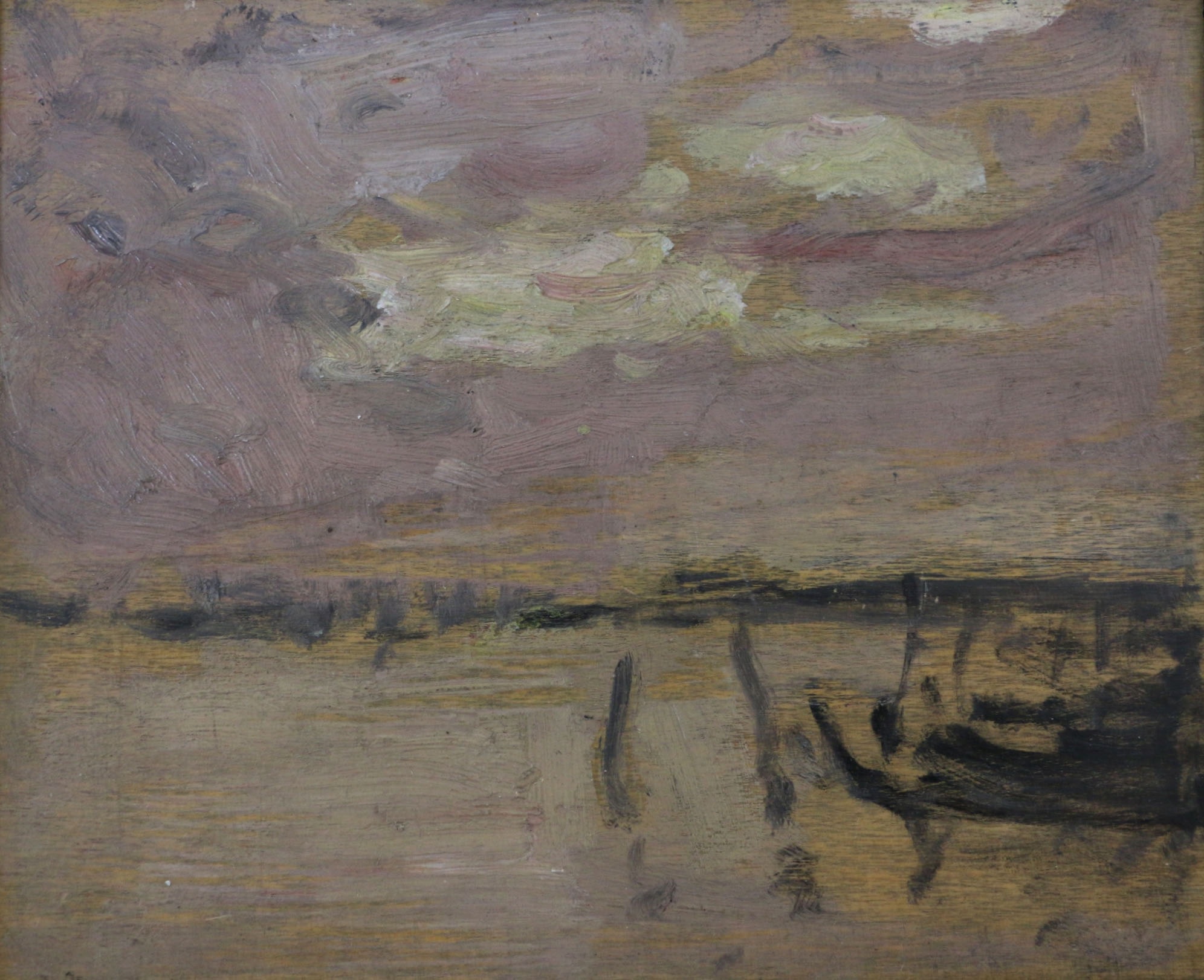Impressions of Venice: James Wilson Morrice’s sketch "Gondolas in the Lagoon"

James Wilson Morrice (1865-1924), Gondolas in the Lagoon, Venice (probably Giudecca), circa 1904. Oil on panel. 5 x 6 in (12.7 x 15.2 cm). Sold by Alan Klinkhoff Gallery.
This beautiful sketch is shown to the public for the first time since Mrs. William Robert Miller, née Harriet Frothingham, bought it from Morrice's executors, Montreal dealers Scott & Sons. It then passed to her niece, and has stayed with her family until now.
When she sent me a small, black and white image of that painting, my art historian friend enumerated the colors, then added "Very delicious", two words, for a little panel that mainly depicts two things... the sky, the water; then we find the "land" on the horizon and, closer to us, flat boats and mooring posts. An inclined one sends our eye back to the mauve sky with its heavy clouds. If we look long enough, the moon appears timidly between the two whiter clouds, just after the sun has set. Note how the artist has used the natural lines of his wood panel to give us a sense of the breeze; he cleverly played on the thickess of his paint to accentuate the clouds at the center or, on the other hand, on its thinness to simulate the evening wind over the nearly still water.
On a surface not bigger than a postcard, and with a very limited palette, Morrice gives us the view, the time of day, and the weather... a lot! And yet so little... this could be anywhere, until we realize that the flat boats are gondolas, which locate the sketch in Venice.
Italy was not on the Canadian's thoughts when he first moved to Europe: England, Wales and Holland were his first ports of call. Then, probably in 1894, he took the train to Venice, on his way to Capri. He did not stay long, just enough to discover two areas where he will paint at each of his visits: the Grand Canal around the Rialto Bridge, and the Riva degli Schiavoni, looking over the Bacino portion of the lagoon (at the foot of the Piazetta di San Marco). Dating from that trip, Evening, the lagoon, Venice [Fig. 1] is an humble precursor to the present sketch.
Probably in 1897, Morrice returned to Venice for a short period of time. He stayed much longer in the summer of 1901; and again in 1902, when he followed William Brymner and Maurice Cullen instead of visiting Spain as first planned. Upon his arrival, he bumped over his new friend, the American painter Charles Fromuth, who wrote how they spent many evenings studying the sun setting on the facades of the Grand Canal near the Rialto; then it was time for "our absinthe", then dinner, before joining friends on Piazza San Marco [1], perhaps followed by a stroll on the Riva. In other words, they spent their time at Morrice's two favorite spots. Venice at the Golden Hour, painted upon Morrice’s return in Paris, is one of the best examples of his "Impressionist” phase; a wonderful study of the sunset, but still based on the detailed description of a rather touristic view.
The Canadian artist returned to Venice in July 1904, via the south of France. No more "tourist" views this time; if he continued to study sun effects on the canali, he selected less well-known palazzi, even a humble building in the fishermen’s quarters on the island of San Pietro, far away from the Rialto or San Marco (Venice [Fig. 2]). At the present time, I tentatively ascribe close to 50 sketches on wood panels to this trip. Many of these panels, as the present Gondolas or the larger Venice just mentioned, were purchased in Venice; obviously, the artist worked much more than he had planned when he left Paris.
The few larger panels, more detailed, were perhaps painted in the artist's hotel room; but all the smaller ones were painted on the motif, often while Morrice was sitting at a café. If we exclude the few French subjects, the Venetian ones showing Grand Canal palazzi or other "structures" (San Marco cathedral, hotel, bridge, Doge's Palace), we still have 16 small panels painted on the quays bordering the Bacino, and all done from the end of the day to the dark of the night. Very rare strollers animate them, but a campanile or the dome of the church of the Salute often breaks the dark silhouette of the horizon. Here are a few examples, showing the whole stretch of the Bacino, from early sunset to the deepest night.
Where did Morrice stand (or sit...) to paint our Gondolas in the Lagoon? The distance between us and the horizon suggest a view towards the island of the Giudecca; but since Morrice has not added, as he often did in this series, the dome of the Salute, he might have walked around the big church unto the quay known as the Zattere, stopping near the present location of the vaporetto stop. But it is not really important: after so many visits to Venice, the artist did not feel the need to tell us “Where” he was, but simply “How” he felt. In pursuing this “Venice at night” atmospheric series, was he thinking of Monet’s Cathedral of Rouen series from 1892-93? Or, further back in the century, the famous Studies of Clouds that Constable had painted in the early 1820s?
Copyright © Lucie Dorais and Alan Klinkhoff Gallery
Complete Cataloguing

James Wilson Morrice (1865-1924)
Gondolas in the Lagoon, Venice (probably Giudecca), circa 1904
Oil on panel
5 x 6 in (12.7 x 15.2 cm)
with black ink studio stamp, "STUDIO / J.W. MORRICE" (verso, centre); inscribed in pencil, "Mrs. W. R. Miller" (verso, upper left).
This work is included in the James Wilson Morrice Catalogue Raisonne compiled by Lucie Dorais.
Provenance
Scott & Sons, Montreal;
Mrs. William Robert Miller, née Harriet Frothingham;
By descent to Private Collection, Montreal
Citations
[1]. Charles Fromuth, Journal, 13 June 1902, p. 92; Washington, DC, Library of Congress.
Figure images withheld.




